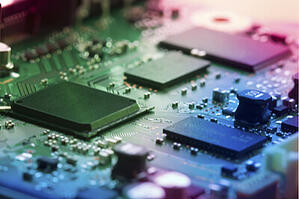Trends in Med Tech Hardware
By Sabyasachi Ghosh, Future Market Insights
We are seeing a rise in medical conditions throughout the general population of the world. The growing number of viruses, impacts of climate change, decreasing immunity and an overload on the medical ecosystem are primary reasons for it. Technology is needed to improve the health of the world. Enter MedTech — a game changer for the medical field — to augment traditional medical devices, tools, and equipment, particularly for application in medical settings like clinics, hospitals, and health centers.

Sabyasachi Ghosh
The rising frequency of chronic diseases is a primary driver of the MedTech market’s expansion. Chronic diseases such as diabetes, cardiovascular disease, and obesity are on the rise around the world, and technology can assist people to manage and avoid these conditions according to Future Market Insights. Medical instruments range in complexity from a basic tongue compressor for throat examinations to complex centrifuges for diagnosing infections in blood samples. Developing tech and instruments to help medical practitioners with illness prevention, diagnosis, treatment, surgery, and patient monitoring is the main aim of MedTech.
There are ample opportunities for startups as well as big companies to disrupt the Med Tech space and have a lasting impact on healthcare delivery and patient well-being. Med Tech is based on two main pillars-hardware and software.
Modern health technology, such as Computed Tomography Scanner (CT Scans), Positron Emission Tomograph (PET Scans), and Magnetic Resonance Imaging (MRI) scanners, all come under this banner. Med Tech hardware enables the medical professionals to design a more effective and goal-oriented treatment plan for the patient. Additionally, MedTech processes and equipment save time for patients and physicians. Due to the advancement in technology, the processes are considerably less complicated now. Given that the first results, like scans and laboratory reports, become error-free, the patient can recover considerably quicker. The goal is more sophisticated, minimally intrusive therapy alternatives. MedTech advocates for shorter hospital stays and fewer rehabilitation requirements, thereby improving the medical model on the whole.
Here are some of the Med Tech Hardware Types:
Diagnostic Hardware
Diagnostic Med Tech Hardware is used to identify the cause or nature of a particular phenomenon, the one that is related to the health of the patient. Pacemakers, temperature monitors, and magnetic resonance imaging machines are examples of diagnostic gadgets. A diagnostic test is carried out in accordance with the symptoms, and the appropriate instrument is used to assess the patient internally. It’s also used when medical professionals or technicians are trying to figure out what’s causing an anomaly in body parts or organs that are exhibiting symptoms.
Durable Medical Equipment (DME)
The main purpose of DME is to offer therapeutic benefits for particular ailments or conditions that need a doctor’s prescription. Durable medical equipment is a reusable, long-lasting machine that can be used to treat patients at home or in a hospital. This long-lasting medical equipment is tested to high-quality standards . It is specifically developed to offer patients the best possible assistance for their safety and well-being for an extended period of time.
Examples of Durable Medical Equipment are hospital beds, nebulizers, insulin pumps, stationary or portable oxygen tanks, manual or electric wheelchairs, and nebulizers.
Life Support Hardware
The purpose of this kind of Life Support Medical Hardware is to preserve a patient’s physiological processes. Sometimes, in critical medical cases, the patient’s organs or systems cannot operate without life support. To overcome this barrier, the medical industry currently offers a variety of life support devices. Some of these Med Tech equipment found in hospitals are heart-lung machines, incubators, and dialysis machines.
Medical Laboratory Hardware
In order to analyze urine, blood, DNA, and other biological material, medical laboratories worldwide have specialized hardware known as medical laboratory equipment. These include coagulation analyzers, drug testing analyzers, electrolyte analyzers, blood collection supplies, centrifugal machines etc. Since the speed and accuracy of testing in the medical treatment cycle are important, advancement in the Medical Laboratory hardware sector aids in shortening hospital stays.
Robot-assisted Surgery and Radiotherapy
These devices offer life-altering advantages thanks to robotics. Surgical robots can help doctors by providing a steady hand for instruments as they are utilized precisely with a variety of attachments and disposable accessories. They can move a patient during radiotherapy without requiring anyone to come inside, which cuts down on the amount of time the operation takes in total.
Prosthetics
Over time, robotic prosthetic hardware has progressed from simple tasks like grasping and walking to more intricate ones like deft finger manipulation and jumping or squatting. Artificial limbs not only increase the quality of life for patients, but they can also aid in the recovery of motor function in critically injured patients. The possibility of mind-controlled robotics is being developed with companies like Neuralink leading the race.
MedTech companies are also equipped to assist hospitals and health systems in transforming the future of health through services, in addition to their hardware product offerings. MedTech companies have the potential to significantly impact patient outcomes, optimize surgeon performance, and lower medical expenses in the near future by offering services including remote patient monitoring, data integration, and storage, and enhanced clinical efficiency. Since healthcare is a field that is heading towards a technological revamp, hardware is expected to play a major role in the medical sector. The next decade is going to be defined by the research and development, manufacturing and deployment of hardware for the betterment of the healthcare system.
About the author
Sabyasachi Ghosh is Associate Vice President at Future Market Insights, Inc. and has over 12 years of experience in the Healthcare, Medical Devices, and Pharmaceutical industries. His primary expertise lies in areas such as Market Entry and Expansion Strategy, Feasibility Studies, Competitive Intelligence, and Strategic Transformation. Holding a degree in Microbiology, Sabyasachi has authored numerous publications and has been cited in journals, including The Journal of mHealth, ITN Online, and Spinal Surgery News.












